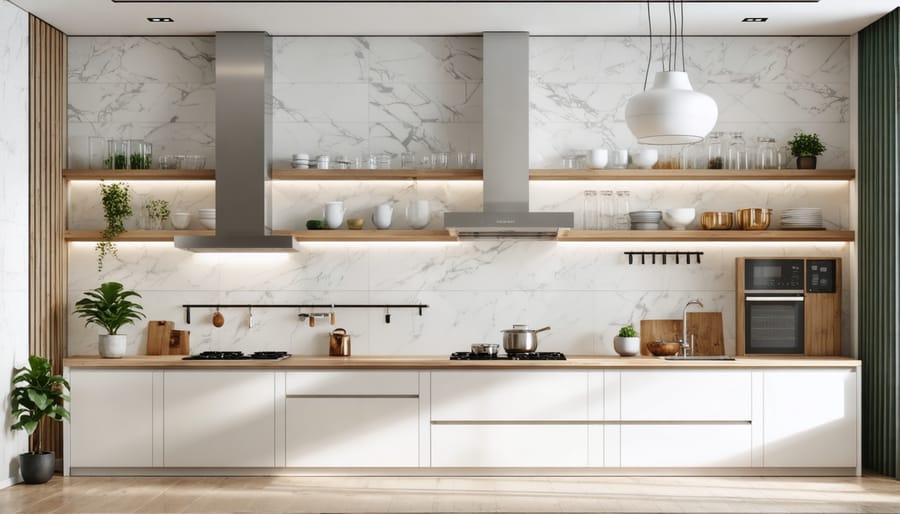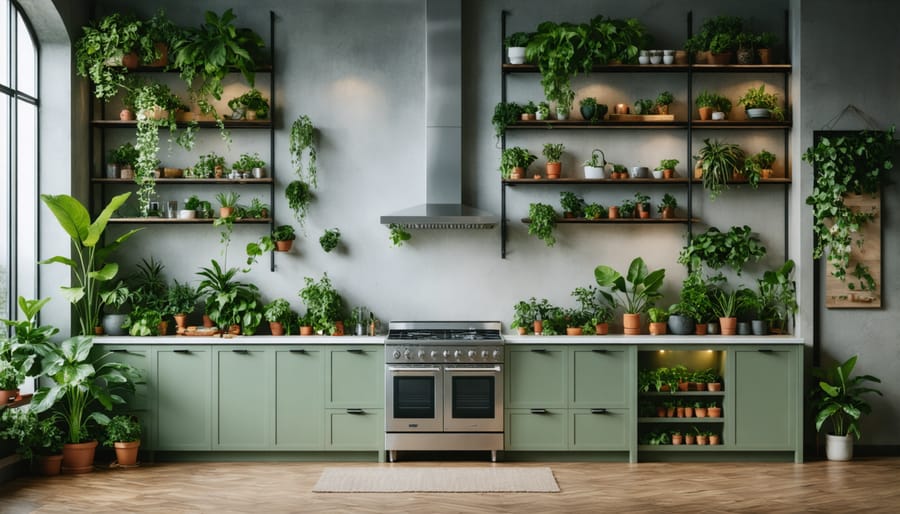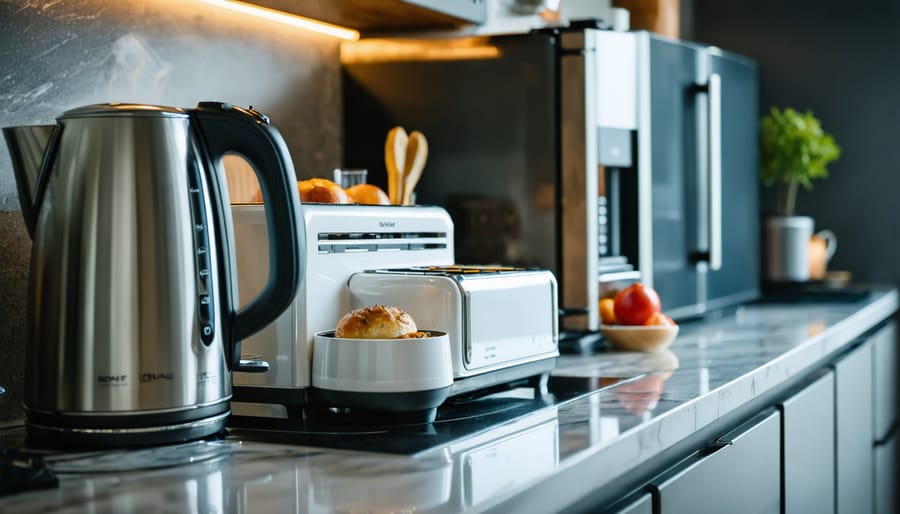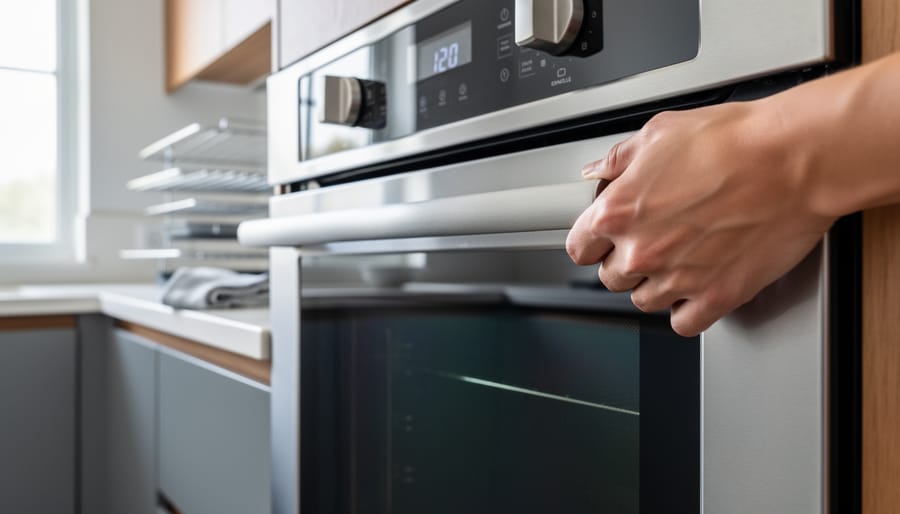Check your circuit breaker’s amperage rating before plugging in multiple high-wattage appliances on the same circuit. Most kitchen circuits run at 15-20 amps (1,800-2,400 watts), and exceeding this causes trips or potential fire hazards. Calculate your total wattage by adding up everything running simultaneously—your electric oven alone can pull 2,400-5,000 watts, while a microwave adds another 600-1,200 watts.
Identify your energy vampires by measuring actual consumption rather than relying on manufacturer estimates. Appliances like coffee makers (800-1,400 watts), toasters (800-1,500 watts), and electric kettles (1,200-1,500 watts) draw substantial power during brief periods, while refrigerators (100-800 watts) consume less per hour but run continuously, making them your biggest monthly expense.
Switch high-wattage appliances to off-peak hours when electricity rates drop, typically evenings and weekends depending on your utility provider. Run your dishwasher (1,200-2,400 watts) and do meal prep with power-hungry tools during these windows to cut costs by 30-50 percent without changing your cooking habits.
Replace outdated appliances pulling excessive wattage with energy-efficient models that maintain performance while reducing consumption. Modern induction cooktops use 1,800 watts compared to traditional electric ranges at 3,000+ watts, and Energy Star refrigerators consume 40 percent less power than 15-year-old models. Just as upgrading to eco-friendly heating solutions reduces whole-home energy waste, strategic kitchen appliance choices create compound savings that lower your monthly bills while supporting a more sustainable household.
Why Kitchen Appliance Wattage Actually Matters
Understanding wattage is simpler than you might think, and it can make a real difference in your monthly budget and environmental footprint. In the most straightforward terms, wattage measures how much electrical power an appliance uses when it’s running. Think of it like the appetite of your appliances—a microwave with 1,000 watts has a bigger “appetite” for electricity than a coffee maker using just 600 watts.
Here’s where it gets practical for your household: the more watts an appliance uses, the more it costs to operate. Your electric company charges you based on kilowatt-hours (kWh), which is simply wattage multiplied by how long you use the appliance. Running a 1,500-watt space heater for one hour uses 1.5 kWh of electricity. Multiply that by your electricity rate, and you’ve got your actual cost per use.
Why does this matter for your home? First, it empowers you to identify which appliances are quietly driving up your electric bills. That innocent-looking coffee maker might not be the culprit, but an old refrigerator running around the clock could be costing you hundreds annually. Second, understanding wattage helps you make smarter purchasing decisions. When shopping for new appliances, you can compare not just sticker prices but long-term operating costs, which often reveals the true value.
For those of us committed to eco-friendly living, wattage awareness is fundamental. Lower-wattage appliances mean less energy demand from power plants, reducing your carbon footprint while keeping your home comfortable and functional. Just as choosing efficient heating solutions creates a warmer, more sustainable home, selecting energy-conscious kitchen appliances contributes to a greener lifestyle without sacrificing the conveniences we love. Knowledge truly is power—especially when it comes to understanding the power your appliances consume.

Complete Kitchen Appliance Wattage Chart
Major Kitchen Appliances
Your major kitchen appliances are the true workhorses of your home, much like how a quality fireplace anchors your living space. Understanding their energy appetites helps you create a more efficient, comfortable home environment while keeping costs manageable.
Refrigerators run continuously, making them one of your highest energy consumers despite their moderate wattage. Modern units typically use 100-800 watts depending on size and efficiency rating, with older models pulling significantly more power. A standard 20-cubic-foot refrigerator averages around 150 watts per hour, but remember, it’s working around the clock to keep your food fresh.
Electric ovens and ranges demand serious power when cooking. A standard electric oven uses 2,000-5,000 watts, while cooktop burners consume 1,200-3,000 watts each. When you’re planning your kitchen layout and considering stove specifications, factor in these electrical requirements to ensure your circuit can handle the load safely.
Dishwashers typically draw 1,200-1,500 watts during operation, with most energy used for heating water. Smart dishwasher placement near your sink and considering energy-efficient models can reduce both water and electricity consumption.
These powerhouse appliances account for roughly 30-40% of your home’s total energy usage. Just as you’d invest in an eco-friendly heating solution for comfort, choosing Energy Star-rated kitchen appliances creates a more sustainable, cost-effective home environment that benefits both your wallet and the planet.

Small Kitchen Appliances
Understanding the energy consumption of your everyday kitchen companions helps you manage both your electric bill and your home’s overall energy efficiency. Small kitchen appliances vary widely in their power requirements, making it essential to know what you’re working with.
Your microwave typically operates between 600 to 1,200 watts, with most standard models hovering around 1,000 watts. While that might sound like a lot, microwaves cook food quickly, so they often use less total energy than conventional cooking methods. Toasters generally run between 800 to 1,500 watts during their brief toasting cycles, while toaster ovens draw 1,200 to 1,800 watts.
Coffee makers present an interesting range. A standard drip coffee maker uses about 550 to 1,200 watts during brewing, though it drops significantly when just keeping coffee warm. Single-serve pod machines typically use less, around 800 to 1,400 watts for their quick heating cycles.
Blenders are relatively modest energy users at 300 to 1,000 watts, depending on their power and features. Air fryers have surged in popularity as energy-efficient cooking alternatives, consuming between 800 to 1,500 watts while often replacing your energy-hungry oven. Slow cookers are remarkably efficient, drawing just 75 to 200 watts during their long cooking times, making them excellent choices for budget-conscious and eco-minded cooks.
By knowing these wattage ranges, you can make smarter decisions about when and how to use your appliances, ultimately creating a more energy-efficient kitchen that complements your home’s comfort goals.
Specialty and Seasonal Appliances
Beyond your everyday kitchen staples, specialty appliances add convenience and enjoyment to your home while contributing to your energy usage in unique ways. Bread makers typically draw 450-600 watts during their kneading and baking cycles, making fresh homemade bread surprisingly efficient. Ice makers use 100-150 watts when actively producing ice, though they cycle on and off throughout the day. Wine coolers operate similarly to small refrigerators at 85-150 watts, running continuously to maintain perfect serving temperatures for your collection. Food processors are powerful workhorses that pull 400-1,200 watts depending on motor strength, but since they run for just minutes at a time, their actual energy impact remains modest. When planning your kitchen’s electrical layout, consider how often you’ll actually use these specialty items. Running a bread maker twice weekly costs pennies compared to store-bought artisan loaves, while a wine cooler’s steady draw adds up over months. Understanding these consumption patterns helps you enjoy life’s little luxuries while keeping your energy budget balanced and your home running efficiently.
The Energy Vampires in Your Kitchen
You might be surprised to learn that some of your most innocent-looking kitchen appliances are quietly sipping electricity even when you think they’re “off.” Just as you carefully monitor your heating costs to keep your home comfortable and efficient, understanding these energy vampires can help you take control of your kitchen’s power consumption.
The biggest offender in most kitchens isn’t what you’d expect. While your refrigerator runs continuously and uses substantial energy—typically 100-800 watts depending on age and size—it’s actually doing legitimate work around the clock. The real vampires are devices that consume power without providing value.
Your microwave, for instance, only uses 600-1,200 watts when heating food, but it draws 3-5 watts in standby mode just to power that clock display. Over a year, that seemingly tiny amount adds up. Coffee makers with digital displays, instant-read features, and programmable settings can drain 1-5 watts while sitting idle. That fancy smart toaster oven with Wi-Fi connectivity? It’s pulling power 24/7 to stay connected.
Here’s where usage patterns matter more than raw wattage ratings. Your electric kettle might draw a hefty 1,500 watts, but it only runs for a few minutes at a time. Compare that to an older second refrigerator in the garage running inefficiently all year, and suddenly that quick-boiling kettle looks downright economical.
The appliances most homeowners overlook are the ones with standby modes, LED displays, or “instant-on” features. Your dishwasher’s control panel, the range hood’s soft-glow light, and even that plugged-in phone charger with no phone attached—they’re all drawing phantom power.
Think of managing kitchen energy consumption like tending a fire: the big logs (major appliances) provide the heat you need, but leaving the flue open when the fire’s out (standby power) wastes energy needlessly. Identifying these vampires is your first step toward a more efficient, eco-friendly kitchen that keeps more money in your pocket each month.

How to Calculate Your Kitchen’s Real Energy Costs
Understanding how much your kitchen appliances actually cost to run is simpler than you might think, and it’s empowering knowledge that can help you make smarter energy decisions throughout your home. Let’s break down the calculation process into easy steps anyone can follow.
First, you’ll need three pieces of information: your appliance’s wattage, how long you use it, and your electricity rate. The wattage is usually listed on a label somewhere on the appliance itself, often on the back or bottom. You can also check the user manual or manufacturer’s website. Your electricity rate appears on your utility bill, typically expressed as cents per kilowatt-hour (kWh). The national average hovers around 16 cents per kWh, but yours may differ.
Here’s the simple formula: (Wattage × Hours Used × Days per Month) ÷ 1,000 × Electricity Rate = Monthly Cost
Let’s walk through a real-world example. Say your coffee maker uses 1,000 watts and runs for 15 minutes each morning. That’s 0.25 hours daily. Over 30 days, you’d use it 7.5 hours total. Following the formula: (1,000 × 7.5) ÷ 1,000 × 0.16 = 1.20. Your morning coffee ritual costs about $1.20 monthly in electricity.
Now let’s try a bigger appliance. Your electric oven might use 3,000 watts. If you cook for an hour three times weekly, that’s 12 hours monthly. The calculation: (3,000 × 12) ÷ 1,000 × 0.16 = 5.76. That’s roughly $5.76 per month. Understanding proper stove usage can help you optimize these costs even further.
When reading appliance labels, look for the yellow EnergyGuide sticker, which provides estimated yearly operating costs based on national averages. While helpful, calculating your specific usage gives more accurate results.
Keep a simple log for one week noting when you use each appliance. Multiply by 4.3 to estimate monthly usage. You might discover surprising energy drains you hadn’t considered.
The beauty of this knowledge extends beyond the kitchen. Just as you’re seeking efficient heating solutions for your home’s comfort, understanding appliance energy use helps create a more sustainable, cost-effective household overall. Small changes in usage patterns can meaningfully impact both your budget and environmental footprint.

Smart Strategies to Reduce Kitchen Energy Consumption
When to Replace vs. Keep Your Old Appliances
Here’s a practical guide to help you decide whether it’s time to upgrade. If your appliance is over 10-15 years old and consuming significantly more wattage than modern equivalents, replacement often makes financial sense. For example, an old refrigerator using 1,500 watts versus a new Energy Star model at 500 watts could save you $150+ annually in electricity costs.
Calculate your potential savings by comparing your current appliance’s wattage against newer models. Multiply the wattage difference by your daily usage hours, then by your electricity rate. If the payback period is under 5 years, upgrading is typically worthwhile.
However, if your appliance is relatively new or lightly used, keeping it remains the eco-friendly choice. Manufacturing new appliances has environmental costs too. Focus instead on optimizing usage patterns and maintaining what you have.
Consider the bigger picture of your home’s energy ecosystem. Just as choosing efficient heating solutions creates lasting comfort and savings, investing in energy-smart kitchen appliances contributes to overall home efficiency. Watch for rebate programs from utility companies that can make upgrades more affordable while reducing your carbon footprint.
Usage Timing and Habits That Save Money
Simple timing changes can dramatically reduce your kitchen’s energy costs without sacrificing convenience. If your utility offers time-of-use rates, shift high-wattage appliance use to off-peak hours when electricity is cheaper. Run your dishwasher late evening or early morning rather than during peak afternoon hours when rates spike.
Batch cooking is your friend for energy efficiency. Instead of heating your oven multiple times throughout the week, prepare several meals at once. Your oven uses the same energy whether it’s cooking one casserole or three. The same principle applies to your electric kettle—boil enough water for multiple cups rather than heating small amounts repeatedly.
Create a mindful routine around your appliances. Thaw frozen items in the refrigerator overnight instead of using the energy-hungry microwave defrost function. Fill your dishwasher completely before running it, and use cold water cycles when possible. These small habit adjustments compound into significant savings over time, much like how thoughtful heating choices create a more efficient, comfortable home environment. The key is being intentional about when and how you use your kitchen’s power-hungry appliances.
Complementing Your Whole-Home Energy Approach
Managing your kitchen’s energy consumption is just one piece of creating a truly efficient, comfortable home. When you pair smart appliance usage with thoughtful heating solutions, you’re building a holistic approach to sustainability that benefits both your wallet and the environment. Consider how your kitchen naturally generates heat during cooking—especially during cooler months. By timing oven and stovetop use strategically, you can reduce the workload on your heating system. Similarly, an efficient fireplace or wood stove can create a cozy gathering space that lets you lower your thermostat while maintaining comfort. The warmth radiating from a well-designed fireplace transforms your living area into an inviting haven, reducing reliance on energy-hungry central heating. Think of your home as an interconnected ecosystem where every energy decision matters. When you’ve optimized your kitchen appliances and embraced eco-friendly heating alternatives, you’re not just cutting costs—you’re creating a sustainable lifestyle that enhances your home’s ambiance and your family’s well-being throughout every season.
Understanding the wattage of your kitchen appliances isn’t just about numbers on a chart—it’s about taking control of your home’s energy story. You now have the knowledge to calculate costs, identify energy vampires, and make choices that align with both your budget and your values. Just like selecting the right heating solution for your living space creates warmth and comfort, optimizing your kitchen’s energy use contributes to an efficient, welcoming home environment that you can feel good about.
The beauty of this information is that you don’t need to overhaul your entire kitchen tomorrow. Small, intentional steps create meaningful change. Start by identifying your highest-wattage appliances and consider whether simple habit shifts—like using your microwave instead of your oven for smaller meals, or running your dishwasher only when full—can make a difference. These eco-friendly practices reduce both your environmental footprint and your monthly expenses.
Here’s your immediate action: Choose one appliance you use daily and calculate its actual monthly cost using the formula we covered. Seeing that concrete number often sparks motivation to explore energy-efficient alternatives or adjust usage patterns. Whether you’re creating cozy gatherings around your fireplace or preparing meals in an energy-conscious kitchen, every choice you make shapes the comfort and sustainability of your home. You’re not just managing wattage—you’re crafting a lifestyle that reflects thoughtful stewardship of your resources and your living space. That’s something worth celebrating.






